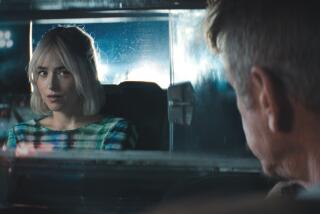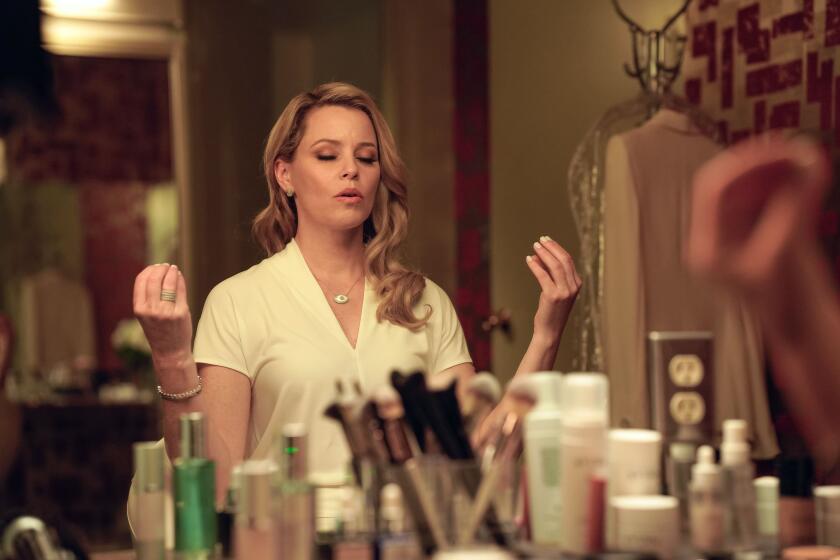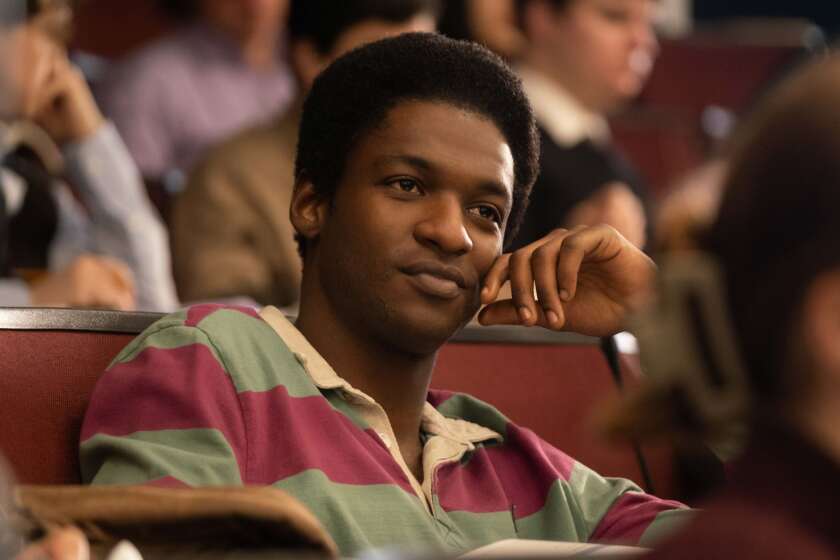MOVIES : ‘Mambo’s’ King : Well-connected N.Y. art dealer Arne Glimcher is not your average first-time film director--and he doesn’t take no for an answer
Other people have probably lied to Warner Bros. President Terry Semel. There probably aren’t too many first-time directors who would turn it into a good story.
But then other first time directors wouldn’t be ensconced, as Arnold Glimcher is, on the fourth floor of the 57th Street gallery he calls his own--the Pace Gallery, where the mighty from Lucerne to Los Angeles come to buy paintings by Picasso, Rothko, Julian Schnabel and Chuck Close.
Glimcher can wear a California denim shirt (he says it’s Italian) and tweed jacket in place of the regulation 57th Street pin-stripes; he can look around him and say, “Listen, the gallery’s my identity. The gallery’s always going to be my identity. It’s 32 years of my life.”
This is no garden-variety first-time screen director in his 20s, trembling before a studio chief, Glimcher wants you to know. He may be making his debut as a film director with “The Mambo Kings,” but he is accustomed to having power, hobnobbing with power and doing things his way. Studio chiefs pick up the phone when he calls--he might just have the Rothko they want to buy.
But he knows how to play the game. He adopted, for West Coast purposes, the nickname Hollywood types gave him: Arne. He acquired the screen rights to “The Mambo Kings Play Songs of Love,” Oscar Hijuelos’ novel about Cuban immigrant musicians in 1950s New York, while it was still in galleys, months before it won the 1989 Pulitzer Prize for literature. And he appointed himself director, because “I just felt I was the only one who could do this.”
It was also his way to cast relative unknowns as the Mambo King brothers--Cesar, with his gargantuan appetite for life, and Nestor the poet, with his melancholic yearning for the past--even though “that was my hardest fight. Once the novel won the Pulitzer, great actors wanted the role, actors any first-time director would kill to work with.”
Glimcher’s not saying who, but “Mambo Kings” screenwriter Cynthia Cidre is: Kevin Kline, Robert De Niro and Jeremy Irons.
Instead, Cesar is Armand Assante (“Little Darlings,” “The Marrying Man,” “Q&A;”) and Nestor is Antonio Banderas, the Spanish star of several Pedro Almodovar films, including “Labyrinth of Passion” and “Tie Me Up! Tie Me Down!”
This is Banderas’ American film debut, and how it happened is the story of Terry Semel and The Lie.
Glimcher had caught Banderas being poetic and melancholy in the Almodovar film “Matador,” and so he went off to London to meet him. “Antonio, who as you can see is about the most charming man in the world, was smiling, laughing, grabbing my arm. But about three or four minutes into the conversation, I said, ‘You don’t understand a word I’m saying, do you?’ And he laughed.”
Glimcher said he’d fight for Banderas on the condition that he study at Berlitz for six hours a day for the next two months and also work with a Cuban English dialect coach.
“And he said he would; he wanted the role desperately. I came back, and--excuse me, Terry Semel, you had so much faith in me and I lied to you--Terry asked, ‘Does he speak English?’ And I said, ‘Perfectly.’ ”
Arne Glimcher will do almost anything to get what he loves. He’s forever falling in love. “Everything happens through relationships,” he says.
Sculptor Louise Nevelson swept into his life when he was 21 and she was 60, her chinchilla-lined paisley sweeping the floor, fabulously fake lashes sweeping her forehead. She was Russian, like his mother, a self-made masterpiece to rival her own sculpture. He coddled her, wrote a 1972 book about her, inducted her into the gallery--and promoted her as the greatest-living-woman-artist by the time she died at the age of 88 in 1988. When she couldn’t stop the Whitney Museum in 1967 from exhibiting “Mountain Woman,” an early work she hated, he helped Nevelson “rearrange” the show, carrying the sculpture across the room and, at her command, dropping and smashing it.
He was so fixated on becoming Willem de Kooning’s dealer that in 1989 he told a court-appointed lawyer, investigating whether the then-84-year-old painter was competent to handle his own affairs by reason of Alzheimer’s, that “the work currently being carried out in the studio . . . (is) among the best De Kooning work he had ever seen.”
Glimcher came on too strong for De Kooning’s conservators. “Arne Glimcher’s a forceful man, but he’s not lovable,” fumed De Kooning’s lawyer, Lee Eastman, at the time.
The conservators have yet to show the paintings to anyone, or choose a dealer. Was that one of the few failures in his life?
He shoots over a laden look. “But no other gallery has him yet,” he points out. “The Museum of Modern Art just bought a 1983 De Kooning painting from me, at a world record price.” It isn’t over.
There are those who would disagree with Eastman about Glimcher’s lovability. Artist Chuck Close, for one. When he lay in a hospital bed two years ago, paralyzed from a rupture in his spinal column, Glimcher came to tell him not to worry about money. In a combination of the incredible painting Close has been doing and Glimcher’s skill, Close’s reputation has soared, his paintings have sold out and his work is making a beeline to major museums.
“Your life moves in patterns toward things, and things that we achieve finally are part of this mosaic,” Glimcher says. “I just think that we create our own fate.”
Given that, his fate was created back in Boston. His Russian immigrant parents moved the family east from Duluth, where his father had a cattle ranch, in order to expose their children to culture. He grew up to act in productions around town and he studied painting. Weekends he and Mildred, his wife of 32 years, danced the mambo and went to the movies. (He did not, as one story Warners is putting out has it, teach the mambo.)
He was 21, married a month, when his father died. The family, gathered for the funeral, went strolling along Newbury Street “for solace,” says Glimcher, and paused before an empty storefront.
“And my brother said, ‘Why don’t you open a gallery? You have to support yourself now.’ ”
By then Glimcher had decided he’d never be the painter he wanted to be, and anyway, all through college he’d been buying and selling prints--Kollwitz, Kandinsky--to support his collecting habit. So with $2,400 borrowed from his brother, he opened the Pace Gallery, named after his father.
Almost immediately, he went to New York and drove back from the Martha Jackson Gallery with a U-Haul filled with Nevelson sculptures--and that critical relationship was established. He talked Claes Oldenburg into sending some of his sculptures of edibles known as “The Store” to Boston. By 1963, he’d moved to New York, where he opened with Nevelson.
Pace was a big, growing gallery with some hot names as well as classical modernist pieces from Europe. But it didn’t really begin to count in the big league until Pace got the rights to sell paintings in the estate of Mark Rothko after his heirs charged his executors with conspiracy and conflict of interest in a bitter 7-year court battle. The loser was Marlborough, a kingpin gallery in New York; the winner was Pace.
That was also about the time that California collectors started showing up. Creative Artists Agency Chairman Michael Ovitz was part of the second wave about a decade ago; he came in to buy a Brice Marden.
In the meantime, Glimcher has aggressively gone after artists. He wooed Schnabel away from another gallery and recently snagged Dan Flavin, an artist of the ‘60s who has languished in obscurity, from Leo Castelli. At the moment, Glimcher and Larry Gagosian are in a pin-striped, uptown version of head-to-head combat as to who will be Castelli’s heir as the art gallery with a leading roster of stars.
Glimcher says his California connections have helped a great deal, particularly in the last three years when the Japanese and most other buyers seem to have dropped out. Last year, when the art market went into cardiac arrest, Pace, he says, had the third best year in its history--and all because of California collectors.
“I can’t deny my familiarity with that world has been very beneficial to my gallery,” he says. “And vice versa.”
In 1982, director Robert Benton, a friend, invited him to play a cameo in “Still of the Night,” bidding at auction opposite Meryl Streep. “I’ve always been in love with the movies. They’re the dreams of the 20th Century,” Glimcher says.
Then Ovitz, his friend, customer and now agent, mentioned to Ivan Reitman that Glimcher might be the man to add a proper art-world look to the Robert Redford-Debra Winger film “Legal Eagles,” for which Glimcher earned an associate producer credit.
Back then, Glimcher said that Ovitz collected Picasso, Dubuffet, Schnabel and David Salle (Salle’s the only one Glimcher doesn’t handle). “I’ve had an influence on his collection,” Glimcher says.
After that Glimcher began acquiring his own movie properties and producing them: “Gorillas in the Mist” and “The Good Mother.”
“Thematically, love interests me most,” he says, “whether it’s Diane Fossey’s love for primates or Diane Keaton’s love for her child.”
He was given the opportunity to direct “The Mambo Kings,” he says, because “I had done a very good job as a producer. I was a person known for some level of taste.”
It’s a film he fought to do when no one else really believed it would fly. “When I showed Mike Ovitz the book, he said it would be a very, very hard movie to get made.”
At one point, Glimcher had gone to three studios and been turned down by all of them. “I lost it so many times I kept financing the movie myself. It was a nightmare.” He had “much more than half a million” dollars of his own money tied up in rights and script development. “A lot of people told me to abandon it. Ovitz said you’re crazy enough to hang on.”
So he went to Semel to ask his advice. They’d worked together on “Gorillas.” Semel had bought art from him even before that. “I always went to him as my consultant about art,” says Semel. “So he came to me as his consultant.
“He came over to my house one weekend and started to talk to me about the problems he was having getting the picture totally greenlighted at another studio. He was asking my opinions and talking about his plans and his ideas and he was so enthusiastic and so filled with passion about the project, and then when we were all through talking I said, ‘And if you can accomplish what I’ve suggested, I think we should do the movie.’ He said, ‘I’ve been dying to ask you the question but didn’t dare.’ ”
Glimcher already had a script. The deal he was offering was that he direct. “That did not frighten me one bit,” says Semel. “It’s not like we haven’t worked with first-time directors before, and Arne has very good taste, very artistic sensibilities, and sitting at my house he was describing each scene. So seated in front of me was a man with real taste, real passion, real vision. I said, ‘The only thing is, if you’re going to direct, you have to surround yourself with real pros.’ ”
Glimcher met the scriptwriter, Cynthia Cidre, through Ovitz’s CAA. They were introduced because she’s from Cuba and a script she’d written about Cuban emigrants was making the rounds. (It became the movie “The Fires Within.”) On the way to the meeting she was listening to the mambo, as she had as a kid during lunchtime in Havana. She told Glimcher the names of all the ‘50s mambo kings. She wrote the script. She became part of his family.
“Writers and directors are natural enemies, but Arne’s like my brother,” she says. “My mother is convinced he’s a Cuban baby who was switched in the hospital, he took so happily to the culture and the food. We get along, we’re going to work together again,” on a project she won’t name.
What attracted both Cidre and Glimcher to this one, they both say, is its immigrant theme. “This is a story that could apply to a Russian, a Vietnamese,” she says. “This is about the American dream.”
“I saw myself in it, my family,” says Glimcher. “It’s about immigrants coming in search of the American dream, about the riskiness of family. Some of the scenes around the table come right out of my Russian grandmother’s house. I love the benign chaos of the family. I love the brothers. I like the idea of a love story between men. There is a great affection between men, which exists much more in ethnic groups: Latin, Italian, Jewish.”
Glimcher wrote “The Mambo Kings’ ” hit song because, Cidre says, “I wouldn’t know how to begin rhyming. He asked me to but it just comes out of his mouth constantly. He remembers every lyric. He just thinks that way. I think other people also wrote other songs and he played them back to me on the phone but this was clearly the best one, the catchiest, the most sentimental in a way that was appropriate to the theme of the book.”
There is a definite look to “Mambo Kings”--the story plays itself out against the opulence of a ‘50s musical if that musical were staged through ‘90s eyes. The most prominent shots in some scenes are of knees, of feet. There’s always a clutter of action and detail; the plot often advances in montages with music instead of dialogue. And there are two pure scenes that take place in a instant-photo booth against a stark, white background. That’s Glimcher’s homage to Andy Warhol and a day in the ‘60s when he took his wife and two sons to Playland to be photographed in that very same photo booth, so that Warhol could paint their portrait.
The film was shot in 50 days, at a cost of about $14 million. Semel says he cried the first time he first saw it.
And now, says Semel, once again, Glimcher is working on another project--so far, on his own. “When we meet we look at each other and grin, and give each other a hug, and he says, ‘Soon.’ ”
More to Read
Only good movies
Get the Indie Focus newsletter, Mark Olsen's weekly guide to the world of cinema.
You may occasionally receive promotional content from the Los Angeles Times.






